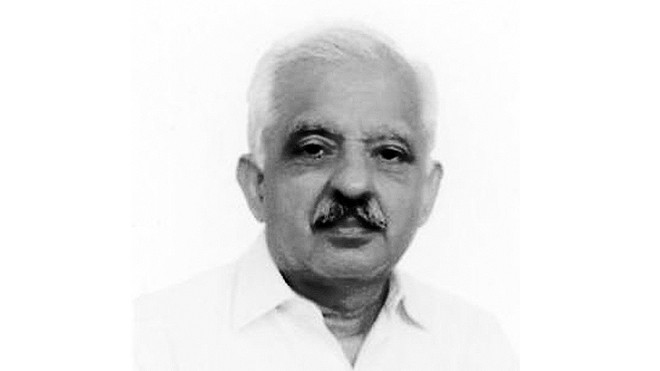
With Pooran Bhagat, Muzaffar Ghaffaar takes Qaadir Yaar’s classical Punjabi poetry and makes it legendary

Muzaffar Ghaffaar has just published his 29th book in his ‘Within Reach’ series of books on Punjabi Classical poetry. Unlike the longer qissa (tale) of Heer Waris Shah which Ghaffaar covered in six volumes, this qissa is much shorter and has been presented in a single, but remarkable volume coupled with translation and detailed notes.
Qaadir Yaar’s classic on Puran is a mere 134 stanzas of four lines each. The legend of Puran Bhagat was well-known in Punjab until some fifty years ago. Now, since our minds have been taken over by a more commercial media and notions of a culture (or lack thereof), we live in utter ignorance of our language and legends. Punjabis tend to
converse with their kids in Urdu, whereas the ‘upper class’ uses English for
communication; hence developing no command over any language. We live in a cultural wasteland, caused by the ‘media fed cultural diet’.
Ghaffaar developed his taste for Punjabi at the weekly Sangat (gathering) for study of Punjabi classics, which used to take place at the house of erudite scholar, writer and teacher of Punjabi language, Najm Hosain Syed. He joined the Sangat in 1989 where he remained a regular participant for more than twenty years. Senior members of the Sangat like myself, who had been a part of it since 1974, resented this ‘upstart’, who would take copious notes during the meeting and offer references from English poetry.
Four of his books of English verse had already been published before he joined Sangat. He also organised weekly art and literature events at the Alhamra Cultural Complex under the banner of LEAF (Lahore Arts Forum). These sessions were mostly trilingual, conducted in Punjabi, Urdu and English. About two thousand sessions under LEAF were conducted by him, before they were discontinued due to lack of adequate support from the cultural bureaucracy. However, they are still remembered by one and all for their invaluable contribution to the life of Lahore.
The ancient story of the Raja of Sialkot, Salwan and his son Puran has been very well-known across Punjab and beyond. The old area of Ichhra in Lahore likely owes its name to Rani Ichhran of the same epic, who was Puran’s biological mother. As the legend goes, Puran was put away in an underground cellar when he was born, on the advice of royal fortune-tellers, as looking at him was believed to be inauspicious for the king, his father Salwan. Puran remained in the cellar, incarcerated for twelve years. Meanwhile, his father, the Raja, married a young girl named Loonan (The Saltish One).
When the twelve year old Puran was released, he went to pay his first respects to the Junior Queen Loonan, where she apparently made untoward advances towards the young boy which he respectfully declined. Feeling humiliated, the Rani exacted her revenge upon him by creating an uproar, accusing, falsely, that he had tried to assault her sexually. Incensed, Raja Salwan ordered for Puran’s arms and legs to be cut off and for him be thrown in a well.
Twelve years later, the Naath from Tilla Jogian saved Puran and, by a ‘miracle’, made him whole again, after which he opted to become a Jogi. The site of ‘Puran Well’ where Puran was said to have been thrown, still exists in Sialkot.
After becoming a jogi, Puran revisited Sialkot and restored his grieving real mother Queen Ichhran’s eyesight. His repentant father, King Salwan begged him to stay but Puran refused. He also gave a curative grain of rice to the barren Queen Loonan, which made the birth of the legendary Raja Risalo possible.
Ghaffaar has translated each four line stanza into English as well as put Gurmukhi along with the original Persian script. His is a scholarly recreation of this classic work by Qaadir Yaar. He also gives a versified version of each passage in English.
The rhymes and alliterations of Qaadir Yaar are excellent. It is set in the alphabetical "si harfi", where you begin the verse by reading the first letter of the word that the verse begins with: as in "Swad, sift husan di hae jhulli …"
Ghaffaar gives us the meaning of each word and translates it in English.
Swad, the quality of beauty is libidinous, seeing Puran, the queen was enamoured instantly
Seeing his face the king forgotten, fire blazed from top to toe violently
Made the son into her heart’s beloved, from within broke her shame’s integrity
Qaadir Yaar sir, the malignant woman, was about to make the stream flow perversely
Shiv Kumar, the most popular poet of modern east Punjab, wrote a book, Loonan in which he took sides with the ‘errant lustful’ queen. But Qaadir Yaar delves deeper in questioning the morality of her behaviour, raising more complex issues of duty and social roles. Qaadir Yaar’s account/poetry is a gift and Muzaffar Ghaffaar has made sure that the gift keeps giving!
Qaadir Yaar’s "Pooran Bhagat" Within Reach
Author: Muzaffar Ghaffaar
Published by: Ferozsons Limited
Pages : 349
Price : Rs1,695